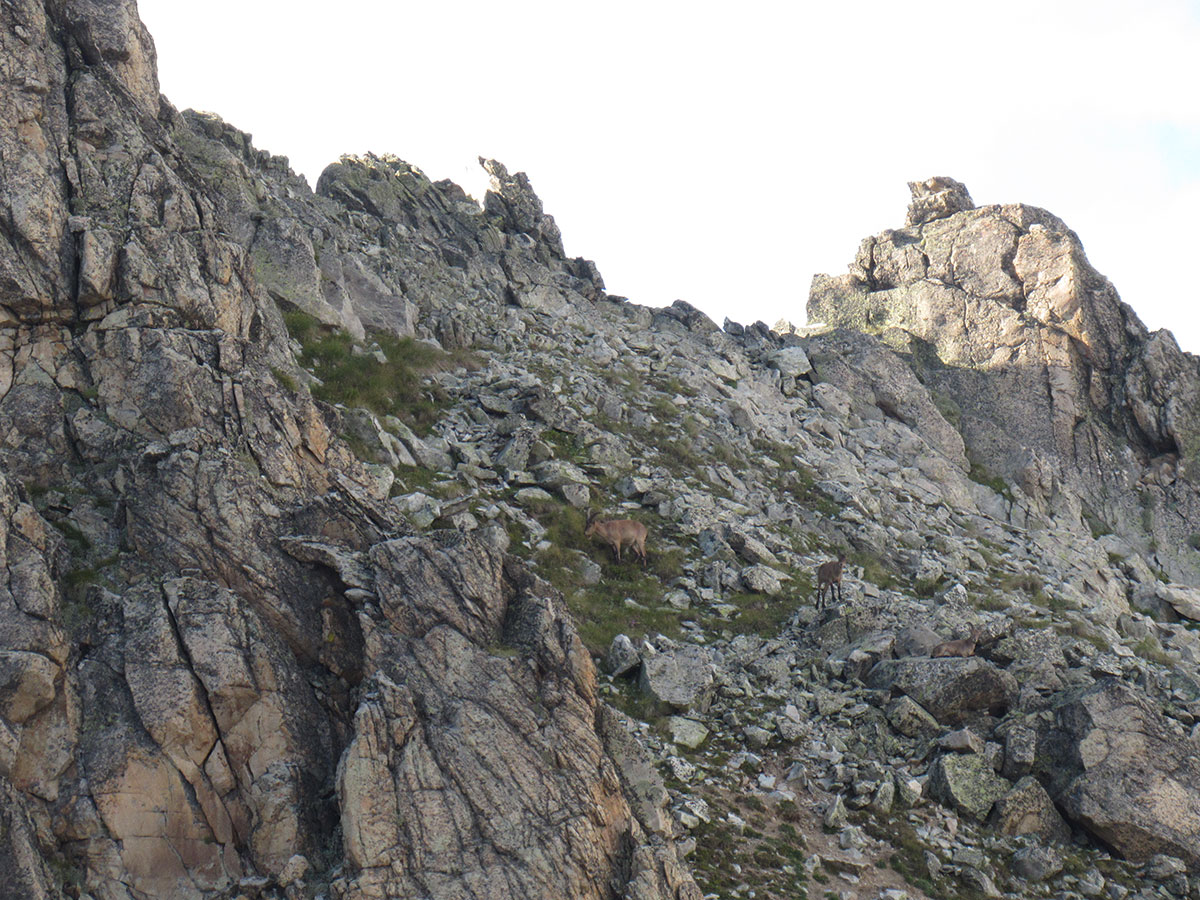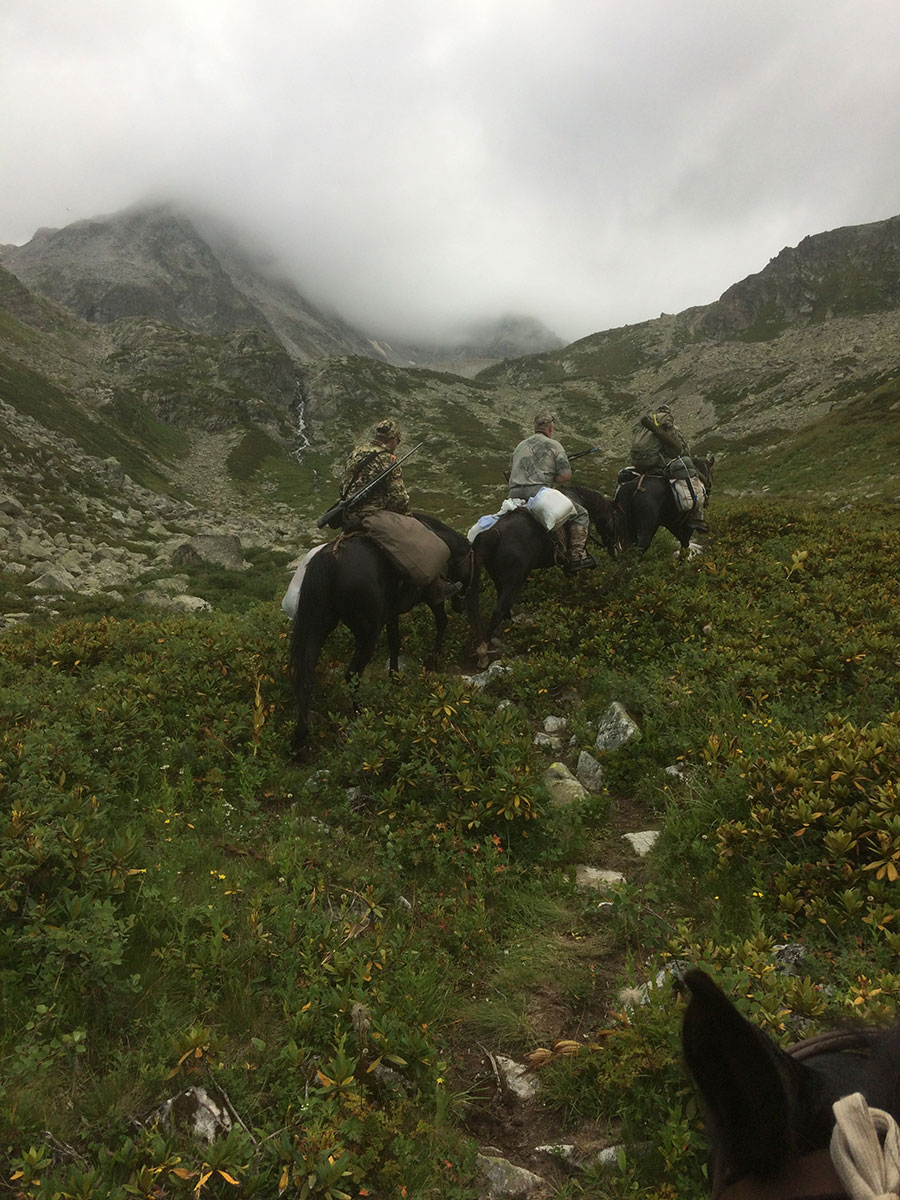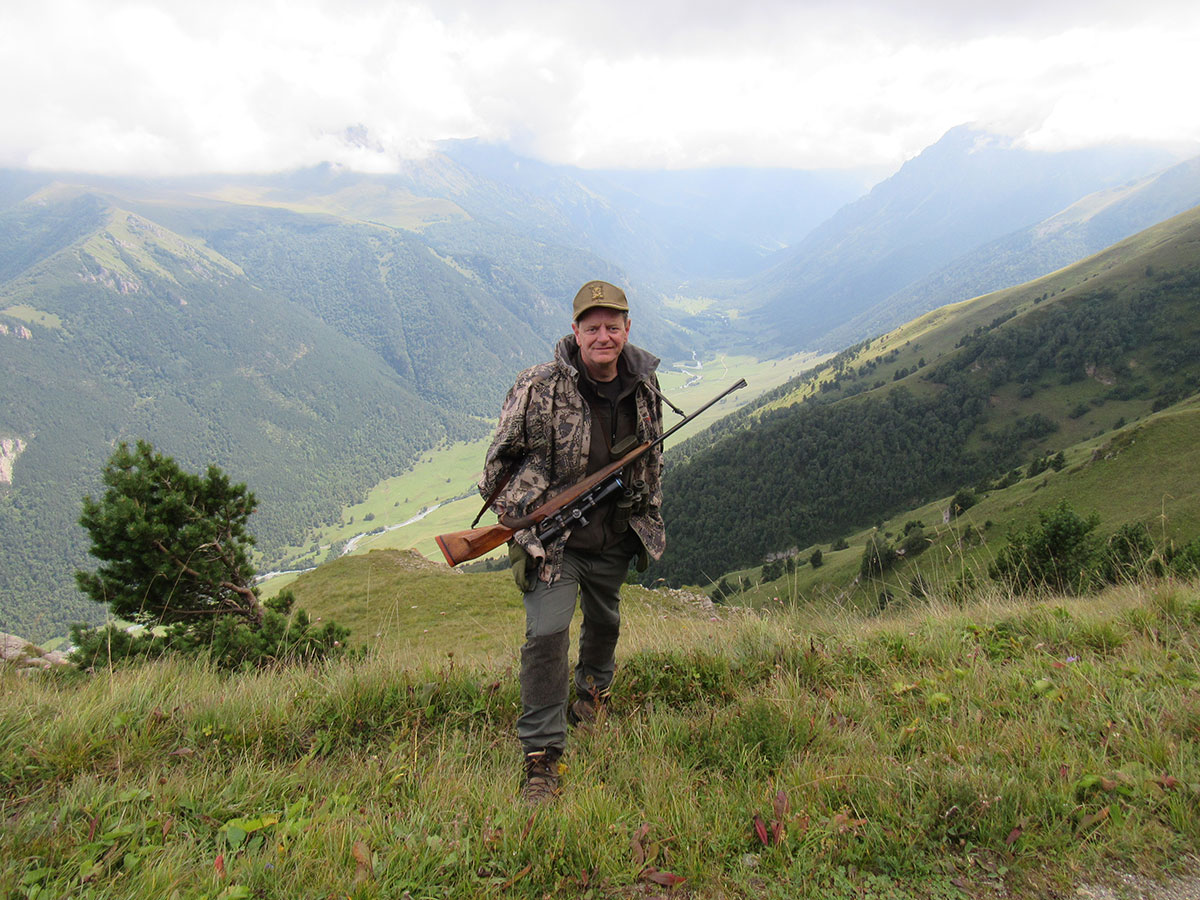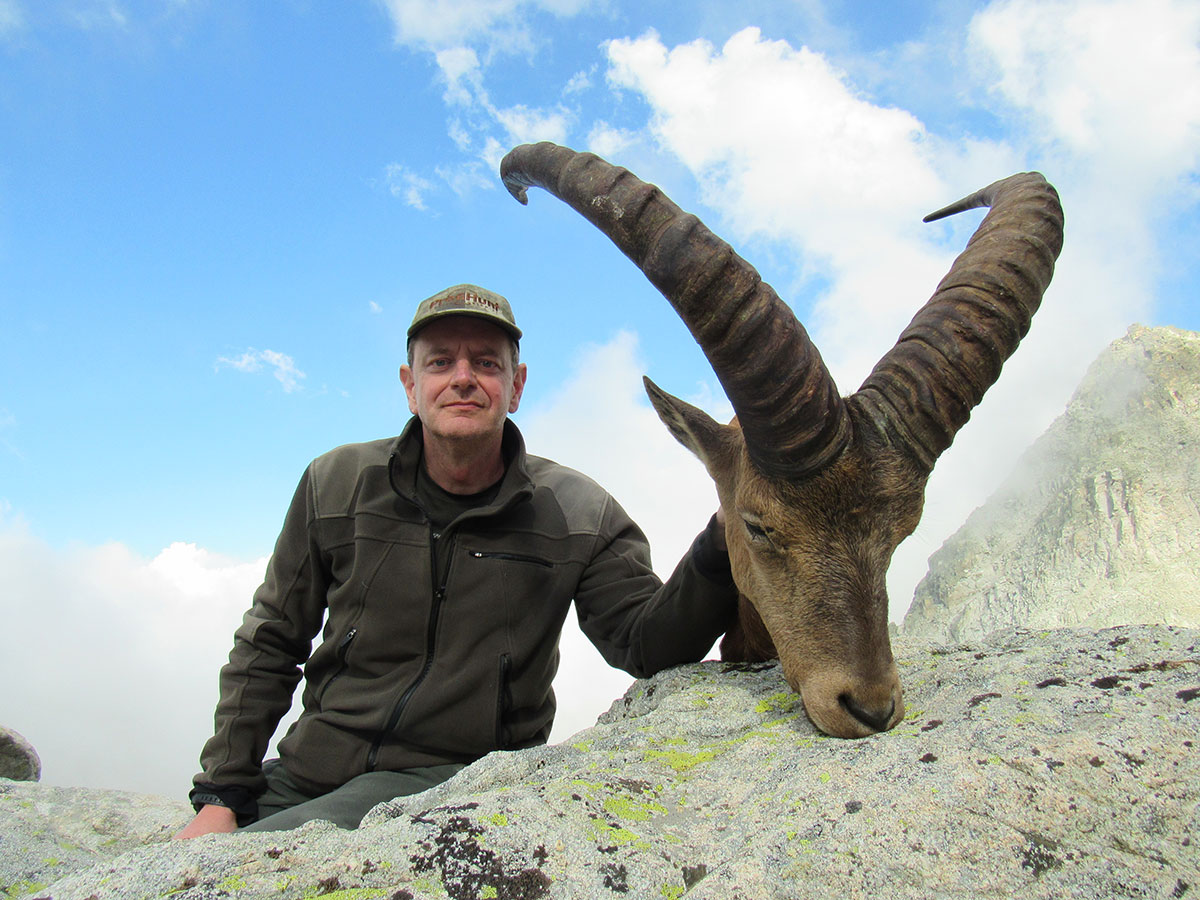Taking a Kuban Tur
The reason for this hunt has its roots in the fascination I developed for mountain hunting in Asia during a trip for Mid-Asian ibex in Kyrgyzstan back in 2013.
My fascination for Capra hunts is something relatively recent, certainly strongly developed since 2010. I started with a small-scale project of collecting all practically available chamois species: then once that was completed in a few years, I then decided to enroll on the quest of achieving the Capra World Slam milestone.
So after the basic chamois species, it was time to shoot a few ibexes: I went to Kyrgyzstan in the summer of 2013 and, although the hunt in itself was a semi-disappointment resulting in only a young male being shot in 10 hard days of hunting, I developed a strong addiction to the wild open spaces of the big Asian ranges, so different from the beloved Western Alps I call home.
There was no way I could achieve a Capra World Slam without taking the three species of tur that inhabit the Caucasus range: with the almost sinister reputation of being the most difficult mountain hunts in the world, I knew I had to find out if it was true.
So I hunted Dagestan Tur in 2014, and immediately knew I wanted to do it again and again: of all my mountain hunting experiences across the world it was the one most closely approximating the mixed stalking / waiting style of hunting that we use for chamois back at home. Another positive thing about tur hunting is that of all mountain game, turs are the most relatively abundant, resulting in an enjoyable hunting experience without the frustration of endless staring at miles of empty mountains.
 So I immediately planned another trip to the Caucasus in 2016, resulting in another trophy — this time of Mid-Caucasian Tur: thanks to the good offices of Artem Veselov of ProfiHunt the trip went very smoothly. By summer 2018 my Capra count stood at 11 species and itching at just one more to claim my Slam.
So I immediately planned another trip to the Caucasus in 2016, resulting in another trophy — this time of Mid-Caucasian Tur: thanks to the good offices of Artem Veselov of ProfiHunt the trip went very smoothly. By summer 2018 my Capra count stood at 11 species and itching at just one more to claim my Slam.
The Kuban Tur was the most logical option: apart from finding one more reason to go to the Caucasus again, it also allowed me to start building my species count for the Ovis Slam totals, even if in that case I have still a very long road to walk. Given the positive experience on Mid-Caucasian tur, it was a no-brainer to book again with Artem of ProfiHunt.
In the early evening hours of Aug 14, 2018: with my good friend Gianclaudio Fossati, I was in Vnukovo airport boarding a Rossiya Airlines flight to Mineral’ne Vody, the gateway to all Caucasus hunts. On our arrival, we were met by Alexey of ProfiHunt who shuttled us to a comfortable hotel. The next morning we started the drive to the Russian republic of Karachevo-Cherkessk, which is the only place in the world with huntable populations of Kuban Tur.
This is a specialized hunt … not many operators. We hunted with Ivan, the largest operator around and the main one ProfiHunt uses for this species. We stopped by his house in Cherkessk to pick up food and camp gear; then we continued into the Aksaut river valley, where we went for Kuban Tur. Gianclaudio hunted lower for Caucasian Chamois.
Eventually, we can to a small copse of wood by the roadside. A tented base camp was quickly established and we grabbed some lunch. A team of sturdy Caucasian horses was ready to go. The horses were saddled and loaded with camp gear and supplies. I waved goodbye to my friend Gianclaudio.
After several hours on horseback, spike camp was setup close to a large boulder that worked as shield against the wind while creating a protected area for a campfire. The next morning after a quick breakfast, we started to climb the grassy ridge behind camp. On top of the ridge the valley opened to huge boulder fields climbing towards a final ridge, which we understood was our final destination.
After more than three hours we reached the final ridge and at the summit we took a rest behind a very large boulder. We waited there for tur.
There was no sign of any animals around … I understand the local hunting tactic is not so much spot-and-stalk, but rather sitting in a commanding place with good visibility to intercept animals on the move.
We waited for a couple of hours behind the boulder. In the early afternoon, Ivan, the head guide, took off on his own to check another valley. I remained alone with Alexey. After another hour or so, Ivan spotted a group of turs feeding in the opposite direction and we moved to intercept them.
 It took us about one hour to do a steep climb to reach a precarious look-out position just below the rim of a very steep ridge, where we found Ali motioning me to stay below cover and pointing to the opposite rim of a large, bowl-shaped valley. About 400 yards away I saw the first tur of the day … a female in the shadow of a group of rocks.
It took us about one hour to do a steep climb to reach a precarious look-out position just below the rim of a very steep ridge, where we found Ali motioning me to stay below cover and pointing to the opposite rim of a large, bowl-shaped valley. About 400 yards away I saw the first tur of the day … a female in the shadow of a group of rocks.
Alexey was with me and said the turs were on the other side of the ridge facing us and would soon cross over and be in shooting range about 300 – 350 meters away.
I positioned myself for the shot. A group of turs appeared. Through the 20-power scope, I spotted a big animal with black front legs and massive horns. Alexey confirmed that it was a good trophy. But it was still far away, more than 350 meters. I preferred to wait for a sure shot. The animal continued to feed in our direction.
Then the big tur was around 300 meters, but it didn’t stop. I chambered a round and wa in a shooting position, just waiting for the correct opportunity, but the animal continued to move and disappeared behind a large rock at about 250 meters.
Alexey said there was a meadow there and the animal would likely reappear in a few minutes. But he didn’t. So, Ali started climbing a peak above the position of the tur. Alexey warned me to be alert. The guide peeked over the peak and the tur bolted away from behind the large rocks. The tur ran away along the rim of the ridge, never presenting me with a shot opportunity. Disappointed, we just watched him disappear across the opposite side.
Day 2 began like the one before: sunshine and a bluebird day. We climbed and then descend slightly towards another pretty, tiny turquoise lake we saw from our spotting place the day before. We descended slightly into the big valley. A field of larger boulders hid us from sight and provided us with excellent visibility all across the valley. Again, there was no sign of animals.
All of a sudden, a commotion started. Ivan spotted a group of turs moving to our left. I immediately grabbed my gun, but from where we lay it was impossible to get in a good shooting position. I struggled to make it work but to no avail. I asked Alexey to show me exactly where the animal was. Coolly, he pointed out a few landmarks. Through my binoculars, I found a bench in a cranny of a vertical cliff, close to a tiny steep meadow. There, looking intently at the commotion 400 meters away and below, lay the male tur. I saw massive bases but not the length and development of the horn, as he was facing directly at us.
 Everybody urged me to shoot but I couldn’t from my position. Three or four meters away, out of cover and in full sight of the animal, there was a flat low rock with enough flat meadow around to do the job nicely. I sprinted there and lay down on the grass, putting my backpack on the rock in front of me and settling my gun on it. I picked up the binoculars again and look for the animal, which had not moved, but continued to look at us.
Everybody urged me to shoot but I couldn’t from my position. Three or four meters away, out of cover and in full sight of the animal, there was a flat low rock with enough flat meadow around to do the job nicely. I sprinted there and lay down on the grass, putting my backpack on the rock in front of me and settling my gun on it. I picked up the binoculars again and look for the animal, which had not moved, but continued to look at us.
He was facing us at 380 meters, corrected at 360 for the elevation difference. There was no alternative. I needed to shoot him then, while he was lying, looking at us on the very rim of the bench. I do not like shooting at frontal targets, but at least I had a clear, unobstructed view of the vital area at the base of the massive neck.
I was shooting my well-worn Ferlacher Mauser in 6.5x68mm, handloaded with a 127-graom RWS KS bullets (for some unknown reason German calibers seem to prefer German bullets) at 1,000 meters per second. It’s my chamois gun with more than 100 animals to its credit, and I have taken all my Capra species save one with it. I put another bag under my backpack to elevate the forearm more and even found a small rock to provide stability for the rubber toe of the stock.
As is common when shooting prone at uphill targets, I could not lie my cheek on the stock, but the picture in the scope was clear and free from dark rings around the outside. After dialing the range on the turret, I zoomed the Huskemaw scope to 20x and put the crosshairs where the massive neck joined the broad chest of the animal. I set the rear trigger and ge-e-ently applied pressure to the front one … the roar of the 6.5×68 shattered the silence of the wide valley.
There was no dust from the rock. I thought that I must have hit home, as the bullet would not exit on a frontal shot. I lost sight of the animal in the recoil, and Asian guides always quickly urge you to shoot again. I worked the bolt, but a second later the happy ending materialized as Alexey said there was no need of it. He took a video of the shot with his camera and on later examination I saw clearly the force of the impact turning the big neck of the animal sideways. The tur dropped off the bench to our right and started to climb on the small steep meadow, only to lose his footing a split second after. He then crumpled and rolled down amongst the rocks.
There was shouting and congratulating! I was then a Capra World Slammer!
At the recovery site, I got to see my trophy clearly. He was a 10-year-old male animal, shorter than I expected but with impressive bases that allow him to score in the Silver class in SCI’s Record Book.
We carefully picked our way through the boulder fields on the return journey to camp. As if to justify my decision to shoot, the weather quickly soured and a heavy curtain of fog came up from the valley floor. Out of the sunshine, a wet cold assailed my body and I put on my Sitka jacket, only to start sweating.
 The small bench we called home for a couple of days was the only area with no fog around. I was elated and excited about the outcome, and as I got into camp for a celebratory toast with the last beer in camp, I was so upbeat that I wandered around for ten minutes with pack on and rifle slung with a lighted cigar and a bottle in hand before realizing that I looked silly and could take my pack off.
The small bench we called home for a couple of days was the only area with no fog around. I was elated and excited about the outcome, and as I got into camp for a celebratory toast with the last beer in camp, I was so upbeat that I wandered around for ten minutes with pack on and rifle slung with a lighted cigar and a bottle in hand before realizing that I looked silly and could take my pack off.
There was no particular celebration over dinner — instant mashed potatoes and tinned beef. The next morning was a sharp contrast to the bluebird weather we had for two days as heavy fog hugged the vertical cliffs around us. It would have been an un-huntable day, and it served as a sharp reminder that in mountain hunting you need to take your chances when you get them, as conditions can change quickly.
My friend Gianclaudio also had been successful, so we decided to drive back to Cherkessk to spend the night in a hotel, a welcome shower and a good dinner. I would start my chamois hunt the next day, but that is for another report.
So, this is the story of the final milestone of my Capra World Slam — a prayer of thanks to the Almighty Lord for providing me with enough blessings to be able to enjoy such experiences. But definitely the biggest thank-you must go to my lifelong wife Elena, for bearing with a passion that often becomes irrational and overbearing.–Andrea Coppo

